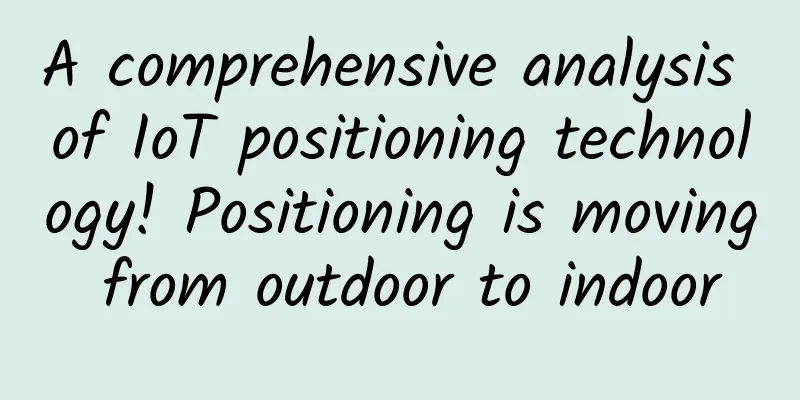A comprehensive analysis of IoT positioning technology! Positioning is moving from outdoor to indoor

|
As early as the 15th century, when humans began to explore the ocean, positioning technology was born. The positioning method at that time was very crude, that is, using nautical charts and star maps to determine one's position. With the progress of society and the development of science and technology, positioning technology has made qualitative leaps in technical means, positioning accuracy, and usability. It has gradually penetrated into all aspects of social life from "high-end" fields such as navigation, aerospace, aviation, surveying and mapping, military, and natural disaster prevention, becoming an indispensable and important application in people's daily lives - such as personnel search, location search, traffic management, vehicle navigation and route planning, etc. Generally speaking, positioning can be divided into two categories according to different usage scenarios: indoor positioning and outdoor positioning. Because the scenarios are different, the needs are also different, so the positioning technologies used are also different.
1. Mature outdoor positioning technology Currently, the mainstream technologies used for outdoor positioning are satellite positioning and base station positioning. 1. Satellite positioning Satellite positioning is the process of positioning by receiving longitude and latitude coordinate signals provided by satellites. The main satellite positioning systems are: the United States Global Positioning System (GPS), Russia's GLONASS, Europe's GALILEO system, and China's Beidou Satellite Navigation System. Among them, the GPS system is the most widely used and most mature satellite positioning technology at this stage. The GPS global satellite positioning system consists of three parts: the space part, the ground control part, and the user equipment part. The space part consists of 24 working satellites, which are evenly distributed on 6 orbital planes (4 satellites on each orbital plane). The distribution of satellites enables more than 4 satellites to be observed anywhere in the world at any time, and can maintain a geometric image with good positioning solution accuracy; The control part is mainly composed of monitoring stations, master control stations, backup master control stations, and information injection stations, and is mainly responsible for the management and control of the GPS satellite array; The user equipment part is mainly a GPS receiver, whose main function is to receive signals transmitted by GPS satellites, obtain positioning information and observation quantities, and achieve positioning through data processing. To put it simply, the positioning principle of GPS is to determine the location of the GPS receiver through four satellites with known positions. To achieve this goal, the position of the satellite can be found in the satellite ephemeris according to the time recorded by the onboard clock. The distance from the user to the satellite is obtained by recording the time it takes for the satellite signal to propagate to the user and then multiplying it by the speed of light (due to interference from the ionosphere in the atmosphere, this distance is not the real distance between the user and the satellite, but a pseudo-distance). When the GPS satellite is working normally, it will continuously transmit navigation messages using pseudo-random codes (pseudo-code for short) composed of 1 and 0 binary code elements. The navigation message includes information such as satellite ephemeris, working status, clock correction, ionospheric delay correction, atmospheric refraction correction, etc. However, since the clock used by the user's receiver cannot always be synchronized with the satellite's onboard clock, in addition to the user's three-dimensional coordinates x, y, and z, a variable t, that is, the time difference between the satellite and the receiver, must be introduced as an unknown number, and then these four unknown numbers are solved using four equations. Therefore, if you want to know the location of the receiver, you must be able to receive signals from at least four satellites. Although satellite positioning has high accuracy and wide coverage, it is expensive and consumes a lot of power, and is not suitable for all users. 2. Base station positioning Base station positioning is generally used for mobile phone users. Mobile base station positioning service is also called mobile location service (LBS, Location Based Service). It obtains the location information of mobile terminal users through the network of telecommunications mobile operators (such as GSM network). After inserting the SIM card and turning on mobile devices such as mobile phones, they will actively search for information about surrounding base stations and establish contact with the base stations. In areas where signals can be searched, mobile phones can search for more than one base station, but at different distances. When communicating, the closest base station with the strongest signal will be selected as the communication base station. The remaining base stations are not useless. When you move, the signal strength of different base stations will change. If the signal of base station A is not as good as that of base station B, the mobile phone will communicate with base station B first to prevent a sudden interruption of the connection. After coordinating the communication method, it will switch from A to B. This is why you consume more power on the train than at home for the same day of standby. The mobile phone needs to constantly search and connect to base stations. The principle of base station positioning is also very simple: we know that the farther away from the base station, the worse the signal. According to the signal strength received by the mobile phone, we can roughly estimate the distance from the base station. When the mobile phone searches for signals from at least three base stations at the same time (this is a very easy thing with the current network coverage), we can roughly estimate the distance from the base station; the base station is unique in the mobile network, and its geographical location is also unique, so we can get the distance between the three base stations (three points) and the mobile phone. According to the three-point positioning principle, we only need to draw circles with the base station as the center and the distance as the radius. The intersection of these circles is the location of the mobile phone. Since the signal is easily interfered with when the base station is positioning, the positioning is inherently inaccurate, with an accuracy of about 150 meters, which is basically impossible to navigate by car. The positioning condition is that it must be in a location with a base station signal, the phone is in a SIM card registered state (it is not possible to turn on wifi in flight mode or remove the SIM card), and it must receive signals from 3 base stations, regardless of whether it is indoors or not. However, the positioning speed is super fast, and it can be positioned once there is a signal. At present, its main use is to quickly and roughly understand your location when there is no GPS and no wifi. 2. Positioning technology moves from outdoor to indoor GPS and base station positioning technologies basically meet users' needs for location services in outdoor scenarios. However, 80% of a person's life is spent indoors, and a large number of positioning needs of individual users, service robots, and new IoT devices also occur indoors; and indoor scenes are blocked by buildings, and GNSS signals decay rapidly or are even completely rejected, which cannot meet the needs of navigation and positioning in indoor scenes. In recent years, location-based services technologies and industries are developing from outdoor to indoor to provide ubiquitous location-based services. The main driving force is the huge application and business potential that indoor location-based services can bring. Many companies, including OS providers, service providers, equipment and chip providers, are competing in this market. 1. Indoor positioning applications Indoor positioning is to obtain the real-time location or movement trajectory of people indoors through technical means. Based on this information, a variety of applications can be realized. Merchants in large shopping malls can use indoor positioning technology to know which places have the largest flow of people, which routes customers usually choose, etc., so as to arrange counters more scientifically or choose locations for promotional activities. Guests can also use indoor positioning technology to more easily find the area where the items they need to buy are placed and get the best route to that place. Parents no longer have to worry about their children getting lost in the mall, as they can use indoor positioning technology to locate their children in real time. Company managers can use indoor positioning technology to obtain real-time information about the status of people in the room, thereby better optimizing the use of air conditioners, etc., achieving the goal of energy conservation and emission reduction, and effectively improving the level of security. By deploying indoor positioning technology, telecom operators can better find "blind spots" and "hot spots" of indoor coverage and better provide communication services to users indoors. 2. Challenges of indoor positioning Compared with outdoor positioning, indoor positioning faces many unique challenges. For example, the indoor environment is very dynamic and diverse. Different buildings have different indoor layouts. The indoor environment is more delicate, so higher accuracy is required to distinguish different features. So what requirements do practical indoor positioning solutions need to meet? They mainly include the following aspects: accuracy, coverage, reliability, cost, power consumption, scalability and response time.
3. Booming Indoor Positioning Technology At present, the commonly used positioning methods for indoor positioning can be mainly divided into seven types in principle: proximity detection method, centroid positioning method, multilateral positioning method, triangulation positioning method, pole method, fingerprint positioning method and dead reckoning method. Different indoor positioning methods select different observation quantities and extract the information required by the algorithm through different observation quantities. The following table briefly introduces the main observation quantities. Based on the positioning principles and observations introduced above, a variety of indoor positioning technologies have been derived. The following is a brief introduction to the mainstream indoor positioning technologies. 1. WiFi positioning technology Currently, WiFi is a relatively mature and widely used technology. In recent years, many companies have invested in this field. There are two main types of WiFi indoor positioning technologies. WiFi positioning generally uses the "nearest neighbor method" to determine the location, that is, the closest hotspot or base station is considered to be at that location. If there are multiple signal sources nearby, cross-positioning (triangulation positioning) can be used to improve positioning accuracy. Since WiFi is already widespread, there is no need to lay special equipment for positioning. When users use their smartphones and turn on Wi-Fi or mobile cellular networks, they can become data sources. This technology has the advantages of easy expansion, automatic data update, and low cost, so it was the first to achieve scale. However, WiFi hotspots are greatly affected by the surrounding environment and have low accuracy. In order to be more accurate, some companies have done WiFi fingerprinting, recording a large number of signal strengths of determined locations in advance, and determining the location by comparing the signal strength of newly added devices with a database with a huge amount of data. Since the collection work requires a large number of personnel and regular maintenance, and the technology is difficult to expand, few companies can regularly update the fingerprint data of so many shopping malls in the country. WiFi positioning can achieve complex large-scale positioning, but the accuracy can only reach about 2 meters, which is not accurate. Therefore, it is suitable for positioning and navigation of people or cars, and can be used in medical institutions, theme parks, factories, shopping malls and other occasions where positioning and navigation are required. 2. FRID positioning The basic principle of RFID positioning is to read the characteristic information of the target RFID tag (such as identity ID, received signal strength, etc.) through a set of fixed readers. The location of the tag can also be determined by the nearest neighbor method, multilateral positioning method, received signal strength and other methods. This technology has a short range, usually tens of meters at most. However, it can obtain centimeter-level positioning accuracy within a few milliseconds, with a large transmission range and low cost. At the same time, due to its non-contact and non-line-of-sight advantages, it is expected to become the preferred indoor positioning technology. At present, the hot spots and difficulties of RFID research lie in the establishment of theoretical propagation models, user security and privacy, and international standardization. The advantages are that the size of the tag is relatively small and the cost is relatively low, but the working distance is short, it does not have communication capabilities, and it is not easy to integrate into other systems. It is impossible to achieve accurate positioning, and the layout of card readers and antennas requires a lot of engineering practice experience and is difficult. 3. Infrared technology Infrared is an electromagnetic wave with a wavelength between radio waves and visible light waves. There are two main specific implementation methods of infrared positioning. One is to attach an electronic tag that emits infrared rays to the positioning object, and use multiple infrared sensors placed indoors to measure the distance or angle of the signal source to calculate the location of the object. This method can easily achieve high accuracy in an open room and can realize passive positioning of infrared radiation sources, but infrared can be easily blocked by obstacles and the transmission distance is not long, so a large number of sensors need to be deployed densely, resulting in high hardware and construction costs. In addition, infrared is easily interfered by heat sources, lights, etc., resulting in reduced positioning precision and accuracy. This technology is currently mainly used in the military for the passive positioning of infrared radiation sources such as aircraft, tanks, and missiles. It is also used for the positioning of indoor self-propelled robots. Another infrared positioning method is infrared weaving, which covers the space to be measured through an infrared network woven by multiple pairs of transmitters and receivers to directly locate the moving target. The advantage of this method is that it does not require the positioning object to carry any terminal or tag, and it is highly concealed and is often used in the security field. The disadvantage is that to achieve high-precision positioning, a large number of infrared receivers and transmitters need to be deployed, which is very expensive, so only high-level security will adopt this technology. 4. Ultrasonic technology Ultrasonic positioning currently mostly uses the reflection ranging method. The system consists of a main rangefinder and several electronic tags. The main rangefinder can be placed on the mobile robot body, and each electronic tag is placed at a fixed position in the indoor space. The positioning process is as follows: the host computer first sends a signal of the same frequency to each electronic tag, which then reflects and transmits it to the main rangefinder after receiving it, so that the distance between each electronic tag and the main rangefinder can be determined and the positioning coordinates can be obtained. At present, there are two more popular technologies based on ultrasonic indoor positioning: one is to combine ultrasonic and radio frequency technology for positioning. Since the transmission rate of radio frequency signals is close to the speed of light, which is much higher than the radio frequency rate, the radio frequency signal can be used to activate the electronic tag first and then make it receive the ultrasonic signal, and the distance can be measured by the time difference method. This technology has low cost, low power consumption and high accuracy. The other is multi-ultrasonic positioning technology. This technology adopts global positioning, and 4 ultrasonic sensors can be installed on the mobile robot in 4 directions to divide the space to be positioned. The ultrasonic sensor measures the distance to form coordinates, grasps the data as a whole, has strong anti-interference ability, high accuracy, and can solve the problem of the robot getting lost. Ultrasonic positioning accuracy can reach centimeters, which is relatively high. However, the disadvantage is that ultrasonic waves attenuate significantly during transmission, thus affecting its effective positioning range. 5. Bluetooth technology Bluetooth positioning is based on the RSSI (Received Signal Strength Indication) positioning principle. Depending on the positioning end, Bluetooth positioning methods are divided into network-side positioning and terminal-side positioning. The network-side positioning system consists of terminals (mobile phones and other terminals with low-power Bluetooth), Bluetooth beacon nodes, Bluetooth gateways, wireless LANs and back-end data servers. The specific positioning process is:
The terminal-side positioning system consists of terminal devices (such as mobile phones embedded with SDK software packages) and beacons. The specific positioning principle is:
Terminal-side positioning is generally used for user terminals such as indoor positioning navigation and precise location marketing; while network-side positioning is mainly used in situations such as personnel tracking and positioning, asset positioning and passenger flow analysis. The advantage of Bluetooth positioning is that it is easy to implement, and the positioning accuracy is closely related to the laying density and transmission power of Bluetooth beacons. It is also very power-saving, and can achieve power saving through deep sleep, connection-free, simple protocol and other methods. 6. Inertial Navigation Technology This is a purely client-side technology that mainly uses motion data collected by terminal inertial sensors, such as accelerometers and gyroscopes, to measure the speed, direction, acceleration and other information of an object. Based on the dead reckoning method, the location information of the object is obtained through various calculations. As walking time increases, the error of inertial navigation positioning is also accumulating. It needs external data sources with higher precision to calibrate it. Therefore, inertial navigation is generally combined with WiFi fingerprints. The indoor position is requested through WiFi every once in a while to correct the error generated by MEMS. This technology is currently commercially mature and widely used in sweeping robots. 7. Ultra-wideband (UWB) positioning technology Ultra-wideband technology is a new wireless communication technology that has emerged in recent years and is very different from traditional communication technology. It does not need to use the carrier in the traditional communication system, but transmits data by sending and receiving extremely narrow pulses with a duration of nanoseconds or microseconds, thus having a bandwidth of 3.1~10.6GHz. At present, countries including the United States, Japan, Canada, etc. are studying this technology, which has a good prospect in the field of wireless indoor positioning. UWB technology is a wireless technology with high transmission rate, low transmission power, strong penetration ability and based on extremely narrow pulses, without carrier. It is these advantages that make it achieve more accurate results in the field of indoor positioning. Ultra-wideband (UWB) positioning technology uses pre-deployed anchor nodes and bridge nodes with known locations to communicate with newly added blind nodes, and uses triangulation or "fingerprint" positioning methods to determine the location. Ultra-wideband can be used for precise indoor positioning, such as battlefield soldier location detection and robot motion tracking. Compared with traditional narrowband systems, ultra-wideband systems have the advantages of strong penetration, low power consumption, good anti-interference effect, high security, low system complexity, and the ability to provide precise positioning accuracy. Therefore, ultra-wideband technology can be applied to the positioning, tracking and navigation of stationary or moving objects and people indoors, and can provide very precise positioning accuracy. Depending on the technical means or algorithms used by different companies, the accuracy can be maintained at 0.1m~0.5m. 8. LED Visible Light Technology Visible light is an emerging field. By encoding each LED light and modulating the ID on the light, the light will continuously emit its own ID, and these codes can be identified by using the front camera of the mobile phone. The corresponding location information is determined in the map database using the obtained identification information to complete the positioning. Qualcomm has achieved centimeter-level positioning accuracy by further refining the positioning results based on the angle of light arrival. Since no additional infrastructure is required, the expansion of the number of terminals has no impact on performance, and a very high accuracy can be achieved. Qualcomm is optimistic about this technology. Currently, visible light technology has been deployed in many shopping malls in North America. After users download the app and go to a shelf in the mall, they can know their specific location by detecting the lights around the shelf. Merchants use this method to promote discounts and other information to consumers. 9. Geomagnetic positioning technology The Earth can be considered as a magnetic dipole, with one pole located near the geographic North Pole and the other near the geographic South Pole. The Earth's magnetic field consists of two parts: the basic magnetic field and the variable magnetic field. The basic magnetic field is the main part of the Earth's magnetic field, originating from the Earth's interior, relatively stable, and belonging to the static magnetic field. The variable magnetic field includes various short-term changes in the Earth's magnetic field, mainly originating from the Earth's interior and relatively weak. The reinforced concrete structure of modern buildings will disturb the geomagnetic field in a local area, and the compass may also be affected. In principle, a non-uniform magnetic field environment will produce different magnetic field observation results due to different paths. This positioning technology, called IndoorAtlas, uses this change in geomagnetic field indoors for indoor navigation, and the navigation accuracy can reach 0.1 to 2 meters. However, the process of using this technology for navigation is still a bit cumbersome. You need to upload the indoor floor plan to the map cloud provided by IndoorAtlas first, and then you need to use its mobile client to record the geomagnetic field in different directions of the target location. The recorded geomagnetic data will be uploaded to the cloud by the client, so that others can use the recorded geomagnetic data for accurate indoor navigation. Baidu made a strategic investment in IndoorAtlas, a geomagnetic positioning technology developer, in 2014, and announced in June 2015 that it would use its geomagnetic positioning technology in its own map application, combining the technology with Wi-Fi hotspot maps and inertial navigation technology. High accuracy, in commercial applications, can achieve meter-level positioning standards, but magnetic signals are easily affected by the constantly changing electrical and magnetic signal sources in the environment, resulting in unstable positioning results and affected accuracy. 10. Visual positioning Visual positioning systems can be divided into two categories: one is to determine the position of the sensor by collecting images through a mobile sensor (such as a camera), and the other is to determine the position of the target in the image by a fixed-position sensor. According to the selection of reference points, it can be divided into reference to 3D building models, images, pre-deployed targets, projected targets, reference to other sensors, and no reference. The reference 3D building model and image are compared with the existing building structure database and pre-calibrated image respectively. In order to improve robustness, the reference pre-deployed target uses the arranged specific image mark (such as QR code) as the reference point; the projected target projects the reference point in the indoor environment based on the reference pre-deployed target. The reference to other sensors can fuse other sensor data to improve accuracy, coverage or robustness. In addition to the above, there are dozens or even hundreds of types of positioning technologies, and each positioning technology has its own advantages and disadvantages and suitable application scenarios. There is no absolute winner or loser. The best strategy is to deploy solutions based on different needs and local conditions. |
<<: What are the advantages of Industrial IoT, and how can companies ensure security?
>>: What is the blockchain that is frequently mentioned on the screen? What is unique about it?
Recommend
Network Technology Outlook 2023: Virtual Networks Will Drive NaaS Development, Cloud-Hosted Security Options Will Explode
What are the most important things that enterpris...
Why is Web 3.0 important? What are the basics you need to know?
Editor's Note: What is Web 3.0? How does it d...
A thorough understanding of container network communication
Author | Chen Yunhao (Huanhe) 1. Background 1. Wh...
10gbiz: Los Angeles CN2/Hong Kong CIA data center VPS monthly payment starts from $2.75
10gbiz has launched a promotion this month, offer...
Millimeter wave and Sub-6GHz complement each other and empower various industries
At present, promoting the development of 5G milli...
Kurun: $59/year-2GB/40GB/1TB@500M/China Telecom CN2 GIA/China Unicom CUII9929/China Mobile CMIN2
Kurun is a domestic merchant founded in 2019. Its...
As the strongest voice in the field of enterprise communications, Youyin Communications has been focusing on this for 13 years!
[51CTO.com original article] Every Sunday at 8 pm...
HostXen fully upgrades KVM, new users get 20 yuan for registration, monthly payment starts from 70 yuan for 6G memory in the United States/Japan/Hong Kong
HostXen sent the latest information, the platform...
Improve efficiency Essential tools on Mac
[[396744]] There are many useful software on Mac,...
How do LoRa and LoRaWAN help build smart cities?
Smart city networks power everything from self-dr...
The dilemma of contemporary 5G users: From being 5G to returning to 4G, we should slow down
If the elderly are the ones abandoned by the Inte...
Detailed family history: How the Internet has changed in the past decade
【51CTO.com Quick Translation】 Since its birth, th...
Casbay: Malaysia/Singapore VPS monthly payment starts from $11.59, 100M unlimited traffic
The Casbay domain name has been registered since ...
How many devices can a wireless AP and a wireless bridge carry? One article to find out
Many friends asked me, what is the capacity of a ...
VULTR: KVM in 17 data centers in Japan, South Korea, Singapore, etc. Monthly payment starts from 3.5 USD, supports hourly billing, and registration will give you 100 USD
VULTR is a foreign VPS merchant founded in 2014. ...









